Professional development takes many forms. School districts provide professional development to educate teachers about curricular adoptions or broad initiatives. Teachers also create their own professional development around aspects of teaching and learning of particular interest to them. They may return to a college classroom, participate in professional book clubs with colleagues, or pursue information on an individual basis. Teachers want to know about new practices, but they also want information to support what they know to be tried-and-true best practices: reading aloud, including children’s literature in the curriculum, and educating the whole child. The bottom line is that teachers must continue to be learners, and the books reviewed in this column speak to both beginning and veteran teachers at all levels of education.
Assessment for Reading Instruction (3rd ed.). Michael C. McKenna, Katherine A. Dougherty Stahl. 2015. Guilford.
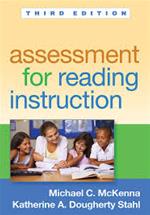 The third edition of McKenna and Stahl’s quintessential Assessment for Reading Instruction addresses three contemporary developments in the teaching of reading: response to intervention (RTI), the Common Core State Standards (CCSS), and the increased realization of the need to assess vocabulary. They maintain the primary strengths of the previous editions’ strong theoretical base and actual assessments. The inclusion of 30 reproducible assessment tools for emergent literacy, word recognition and spelling, fluency, vocabulary, comprehension, strategic knowledge, and affective factors sets this text apart from other assessment texts. McKenna and Stahl encourage teachers to focus on students’ strengths as well as weaknesses. Most important, they emphasize the primacy of interpreting assessment results in ways that inform instruction. A webpage with downloadable reproducible materials has been created for those who purchase the book. This is an invaluable resource for teachers who seek specific and meaningful information about their student readers.
The third edition of McKenna and Stahl’s quintessential Assessment for Reading Instruction addresses three contemporary developments in the teaching of reading: response to intervention (RTI), the Common Core State Standards (CCSS), and the increased realization of the need to assess vocabulary. They maintain the primary strengths of the previous editions’ strong theoretical base and actual assessments. The inclusion of 30 reproducible assessment tools for emergent literacy, word recognition and spelling, fluency, vocabulary, comprehension, strategic knowledge, and affective factors sets this text apart from other assessment texts. McKenna and Stahl encourage teachers to focus on students’ strengths as well as weaknesses. Most important, they emphasize the primacy of interpreting assessment results in ways that inform instruction. A webpage with downloadable reproducible materials has been created for those who purchase the book. This is an invaluable resource for teachers who seek specific and meaningful information about their student readers.
–LTP
Children’s Literature in the Reading Program: Engaging Young Readers in the 21st Century (4th ed.). Deborah A.Wooten, Bernice E. Cullinan. 2015. International Literacy Association.
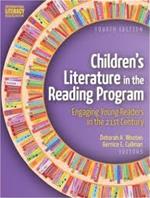 With the continued emphasis on standardized testing and misunderstanding of the Common Core State Standards, many schools are increasingly turning to commercial reading programs that provide little opportunity for students to actually read. At the heart of this edition is an awareness of the importance of expanding the breadth and volume of students’ reading. The contributors address educators’ expressed need for theory and research supporting the inclusion of children’s literature in the classroom, strategies to improve students’ literacy learning without diminishing their desire to read, innovative ways to create text sets that include a variety of genres and formats, and guidance in identifying quality multicultural and global books. The ideas presented in this edition of Children’s Literature in the Reading Program will enrich the teaching practices of both new teachers and seasoned veterans.
With the continued emphasis on standardized testing and misunderstanding of the Common Core State Standards, many schools are increasingly turning to commercial reading programs that provide little opportunity for students to actually read. At the heart of this edition is an awareness of the importance of expanding the breadth and volume of students’ reading. The contributors address educators’ expressed need for theory and research supporting the inclusion of children’s literature in the classroom, strategies to improve students’ literacy learning without diminishing their desire to read, innovative ways to create text sets that include a variety of genres and formats, and guidance in identifying quality multicultural and global books. The ideas presented in this edition of Children’s Literature in the Reading Program will enrich the teaching practices of both new teachers and seasoned veterans.
–LTP
Digital Reading: What’s Essential in Grades 3-8. William L. Bass II, Franki Sibberson. 2015. National Council of Teachers of English.
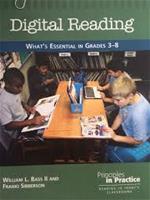 Teachers who are interested in broadening their understanding of the essential role digital reading can play in 21st-century classrooms now have a professional text designed for just this purpose. Bass and Sibberson expand our definition of reading beyond the traditional designation of print to include digital formats. The authors help connect students’ expertise in technology and digital reading brought from home to classroom contexts. They explore a variety of digital tools and texts for enhancing learning, showing educators how to integrate these tools and texts into the curriculum and across content areas. The authors draw upon “Reading Instruction for All Students,” a Policy Research Brief produced by the National Council of Teachers of English, which argues that visual and digital texts demand that students approach the task of reading differently. Emphasizing authentic digital learning experiences characterized by intentional instructional design, this professional text includes a wealth of practical examples from the authors’ classrooms, as well as the classrooms of their fellow teachers. Packed with practical advice and useful tools, this valuable resource guides teachers across the ever-expanding digital landscape.
Teachers who are interested in broadening their understanding of the essential role digital reading can play in 21st-century classrooms now have a professional text designed for just this purpose. Bass and Sibberson expand our definition of reading beyond the traditional designation of print to include digital formats. The authors help connect students’ expertise in technology and digital reading brought from home to classroom contexts. They explore a variety of digital tools and texts for enhancing learning, showing educators how to integrate these tools and texts into the curriculum and across content areas. The authors draw upon “Reading Instruction for All Students,” a Policy Research Brief produced by the National Council of Teachers of English, which argues that visual and digital texts demand that students approach the task of reading differently. Emphasizing authentic digital learning experiences characterized by intentional instructional design, this professional text includes a wealth of practical examples from the authors’ classrooms, as well as the classrooms of their fellow teachers. Packed with practical advice and useful tools, this valuable resource guides teachers across the ever-expanding digital landscape.
–LDP
Handbook of Reading Assessment: A One-Stop Resource for Prospective and Practicing Educators (2nd ed.). Sherry Mee Bell, R. Steve McCallum. 2016. Routledge/Taylor and Francis Group.
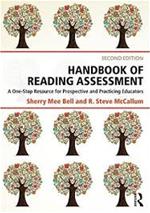 The preface to the Handbook of Reading Assessment states that the primary goal of this edition is to “provide the assessment knowledge educators need to improve their practice and better understand the assessment-instructional link” (p. xv), and this edition does not disappoint. Within the framework of an inclusive model of reading, educational professionals from various disciplines will gain assessment knowledge, develop a common language for communication across disciplines, and make meaningful theory/practice connections. The theoretical grounding is impressively strong as are the practical applications of each area of assessment: a perfect marriage. The authors discuss formative and summative assessments in areas including motivation to read, informal reading assessments, progress monitoring, and individual and group formal assessments. In an era of high-stakes standardized tests, this is an important resource and source of empowerment for teachers who work with students on a daily basis. A companion website offers additional resources.
The preface to the Handbook of Reading Assessment states that the primary goal of this edition is to “provide the assessment knowledge educators need to improve their practice and better understand the assessment-instructional link” (p. xv), and this edition does not disappoint. Within the framework of an inclusive model of reading, educational professionals from various disciplines will gain assessment knowledge, develop a common language for communication across disciplines, and make meaningful theory/practice connections. The theoretical grounding is impressively strong as are the practical applications of each area of assessment: a perfect marriage. The authors discuss formative and summative assessments in areas including motivation to read, informal reading assessments, progress monitoring, and individual and group formal assessments. In an era of high-stakes standardized tests, this is an important resource and source of empowerment for teachers who work with students on a daily basis. A companion website offers additional resources.
–LTP
In Defense of Read-Aloud: Sustaining Best Practice. Stephen L. Layne. 2015. Stenhouse.
 Stephen Layne is preaching to this choir member in In Defense of Read-Aloud, but what a sermon he delivers! Regie Routman’s foreword sets the tone for the book then Layne takes over, accompanied by a chorus of primary, intermediate, and secondary educators, respected teachers, and master practitioners. Layne presents historical and contemporary research supporting read-aloud as best practice and poses the question, “Why doesn’t our practice match our verbalized intent?” With gentle (and over-the-top) wit and humor, Layne presents best practices for orchestrating read-aloud, selecting appropriate read-aloud titles, and reading aloud as an art form. The final chapter includes favorite read-aloud books of K–12 practitioners, literacy gurus, current and past presidents of premier literacy associations, and Layne himself. Each chapter opens with correspondence between a practicing teacher and a well-known author and concludes with e-mails between Layne and educators regarding their read-aloud dilemmas. Respected voices in the field also provide position statements regarding read-aloud.
Stephen Layne is preaching to this choir member in In Defense of Read-Aloud, but what a sermon he delivers! Regie Routman’s foreword sets the tone for the book then Layne takes over, accompanied by a chorus of primary, intermediate, and secondary educators, respected teachers, and master practitioners. Layne presents historical and contemporary research supporting read-aloud as best practice and poses the question, “Why doesn’t our practice match our verbalized intent?” With gentle (and over-the-top) wit and humor, Layne presents best practices for orchestrating read-aloud, selecting appropriate read-aloud titles, and reading aloud as an art form. The final chapter includes favorite read-aloud books of K–12 practitioners, literacy gurus, current and past presidents of premier literacy associations, and Layne himself. Each chapter opens with correspondence between a practicing teacher and a well-known author and concludes with e-mails between Layne and educators regarding their read-aloud dilemmas. Respected voices in the field also provide position statements regarding read-aloud.
–LTP
In the Best Interest of Students: Staying True to What Works in the ELA Classroom. Kelly Gallagher. 2015. Stenhouse.
Those who read Gallagher’s Readicide (2009) will be delighted with this new offering, and those who haven’t discovered it will definitely want to seek it out after reading In the Best Interest of Students. With his standard wit and insight, and in alternating chapters, Gallagher examines what the CCSS in reading, writing, speaking and listening do and do not get right. Reminding us that standards come and go, he encourages us to fit the current standards around our teaching rather than tailoring our teaching to fit the standards. In the final chapter, Gallagher advocates for changing the 50/50 Approach he proposed in Readicide to a 20/80 Approach and maps out what 20% whole-class, challenging, close reading balanced with 80% extended, small-group, and independent reading would look like. As always, Gallagher gives us much to think about regarding our practice as educators.
–LTP
Let’s Talk: One-on-One, Peer, and Small-Group Writing Conferences. Mark Overmeyer. 2015. Stenhouse.
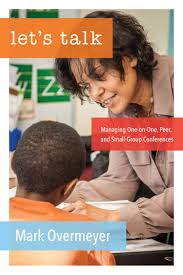 Let’s Talk is a valuable resource for professionals who use a workshop framework to teach writing. Overmeyer examines the role of talk in the Writing Workshop and offers practical support for making conferences more manageable and meaningful. He offers multiple ways to structure talk in the workshop, including the traditional talk between teachers and students, as well as talk between students and their fellow writers. Three types of teacher–student conferencing are explored: the classic conference, involving one teacher and one student; the guided writing conference, involving one teacher and several students; and the public author’s chair conference, involving one teacher and many students. Overmeyer extends our notion of workshop talk to include peer writing conferences, including pairs and small groups of students. The qualities of effective feedback are explored, as well as strategies for working with English language learners. The author weaves entertaining stories about his own students’ writing experiences throughout the text, along with actual samples of their writing. A theme carried throughout this professional text is a commitment to creating positive writing memories within communities of writers. Useful forms for conference note-taking and record-keeping are included.
Let’s Talk is a valuable resource for professionals who use a workshop framework to teach writing. Overmeyer examines the role of talk in the Writing Workshop and offers practical support for making conferences more manageable and meaningful. He offers multiple ways to structure talk in the workshop, including the traditional talk between teachers and students, as well as talk between students and their fellow writers. Three types of teacher–student conferencing are explored: the classic conference, involving one teacher and one student; the guided writing conference, involving one teacher and several students; and the public author’s chair conference, involving one teacher and many students. Overmeyer extends our notion of workshop talk to include peer writing conferences, including pairs and small groups of students. The qualities of effective feedback are explored, as well as strategies for working with English language learners. The author weaves entertaining stories about his own students’ writing experiences throughout the text, along with actual samples of their writing. A theme carried throughout this professional text is a commitment to creating positive writing memories within communities of writers. Useful forms for conference note-taking and record-keeping are included.
–LDP
The Reading Strategies Book: Your Everything Guide to Developing Skilled Readers. Jennifer Serravallo. 2015. Heinemann.
 Teachers familiar with Conferring with Readers, The Literacy Teacherersaders op, and Teaching Reading in Small Groups will be pleased to discover a new professional book by the best-selling author. This robust resource offers teachers over 300 reading strategies, which the author describes as “reading recipes.” The strategies are organized by 13 goals, and each chapter begins with an extensive explanation of the reading goal. Serravallo urges teachers to match individual goals to individual readers, promoting differentiated literacy instruction. The strategies are designed to support preemergent and emergent readers, print work, comprehension in fiction and nonfiction, and studentsdents and nonfiction, and studentsallo urges teluency; and improve writing about reading. Each strategy includes an explanation of the strategy itself, a teaching tip, prompts, and a sample visual to support readers. Other resources entail targeted Fountas & Pinnell reading levels, text genre and types, and reading skills. The author includes helpful language for prompting and guiding readers, as well as for demonstrating and explaining the craft of reading. This comprehensive professional text is designed to be used with any reading program or approach.
Teachers familiar with Conferring with Readers, The Literacy Teacherersaders op, and Teaching Reading in Small Groups will be pleased to discover a new professional book by the best-selling author. This robust resource offers teachers over 300 reading strategies, which the author describes as “reading recipes.” The strategies are organized by 13 goals, and each chapter begins with an extensive explanation of the reading goal. Serravallo urges teachers to match individual goals to individual readers, promoting differentiated literacy instruction. The strategies are designed to support preemergent and emergent readers, print work, comprehension in fiction and nonfiction, and studentsdents and nonfiction, and studentsallo urges teluency; and improve writing about reading. Each strategy includes an explanation of the strategy itself, a teaching tip, prompts, and a sample visual to support readers. Other resources entail targeted Fountas & Pinnell reading levels, text genre and types, and reading skills. The author includes helpful language for prompting and guiding readers, as well as for demonstrating and explaining the craft of reading. This comprehensive professional text is designed to be used with any reading program or approach.
–LDP
Sharing the Blue Crayon: How to Integrate Social, Emotional and Literacy Learning. Mary Anne Buckley. 2015. Stenhouse.
 The social emotional learning of young children can become subsumed by an ever-increasing emphasis on standards and testing requirements. Buckley’s Friendship Workshop seeks to counteract these effects, building classroom communities around the social and emotional languages of children. These communities are characterized by respect and care, as well as high engagement in learning and problem solving. The Friendship Workshop teaches children how to build empathy and trust through the sharing of personal stories and powerful feelings. According to Buckley: “Friendship Workshop is a conscious approach to helping children identify and regulate their emotions so they can make choices that support their relationships and their schooling” (p. 3). Strategies are explored for working with special populations of students, such as English language learners and children from high-poverty home environments. The author introduces the format for conducting a Friendship Workshop and extends the workshop to literacy lessons. A variety of concepts are explored, such as the language of learning, self-regulation skills, getting along as part of a group, and giving and receiving feedback. The author shares heartwarming anecdotes from her early childhood classrooms to illustrate the workshop elements and goals.
The social emotional learning of young children can become subsumed by an ever-increasing emphasis on standards and testing requirements. Buckley’s Friendship Workshop seeks to counteract these effects, building classroom communities around the social and emotional languages of children. These communities are characterized by respect and care, as well as high engagement in learning and problem solving. The Friendship Workshop teaches children how to build empathy and trust through the sharing of personal stories and powerful feelings. According to Buckley: “Friendship Workshop is a conscious approach to helping children identify and regulate their emotions so they can make choices that support their relationships and their schooling” (p. 3). Strategies are explored for working with special populations of students, such as English language learners and children from high-poverty home environments. The author introduces the format for conducting a Friendship Workshop and extends the workshop to literacy lessons. A variety of concepts are explored, such as the language of learning, self-regulation skills, getting along as part of a group, and giving and receiving feedback. The author shares heartwarming anecdotes from her early childhood classrooms to illustrate the workshop elements and goals.
–LDP
Writers ARE Readers: Flipping Reading Instruction Into Writing Opportunities. Lester L. Laminack, Reba M. Wadsworth. 2015. Heinemann.
 The best-selling authors of Learning Under the Influence of Language and Literature and Reading Aloud Across the Curriculum have a new offering that highlights the reciprocity of the reading and writing processes. Rather than the traditional approach of separating reading and writing instruction, the authors advocate for their connection, increasing both efficiency and effectiveness of literacy teaching and learning. Laminack and Wadsworth propose a new idea that they call “flipsides,” which is the notion that each reader insight can be flipped into an insight for the writer. According to the authors: “Our focus here is to help readers see the flipside of those actions, gain insight into the writing behind them, and then activate those insights as writers” (p. viii). The book is organized into three sections: text structure and organization, weaving meaning (comprehension strategies), and story elements. Sample lessons and student writing samples illustrate how to flip reader knowledge and apply it to knowledge of writing. Recommended children’s literature titles for each section provide teachers with a valuable resource.
The best-selling authors of Learning Under the Influence of Language and Literature and Reading Aloud Across the Curriculum have a new offering that highlights the reciprocity of the reading and writing processes. Rather than the traditional approach of separating reading and writing instruction, the authors advocate for their connection, increasing both efficiency and effectiveness of literacy teaching and learning. Laminack and Wadsworth propose a new idea that they call “flipsides,” which is the notion that each reader insight can be flipped into an insight for the writer. According to the authors: “Our focus here is to help readers see the flipside of those actions, gain insight into the writing behind them, and then activate those insights as writers” (p. viii). The book is organized into three sections: text structure and organization, weaving meaning (comprehension strategies), and story elements. Sample lessons and student writing samples illustrate how to flip reader knowledge and apply it to knowledge of writing. Recommended children’s literature titles for each section provide teachers with a valuable resource.
–LDP
Linda T. Parsons is an associate professor in the Department of Teaching and Learning on the Marion Campus of The Ohio State University where she specializes in middle childhood literacy and young adult literature. Lisa D. Patrick is a literacy coach trainer at The Ohio State University’s Literacy Collaborative where she specializes in children’s literature and early literacy.
These reviews are submitted by members of the International Reading Association's Children's Literature and Reading Special Interest Group (CL/R SIG) and are published weekly on Literacy Daily.